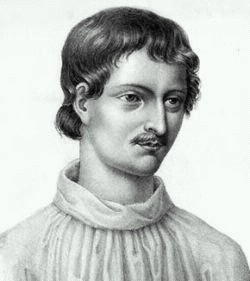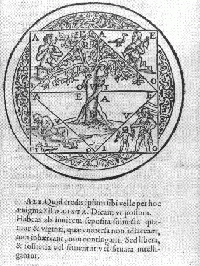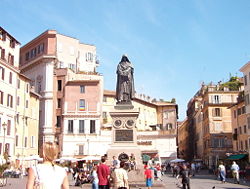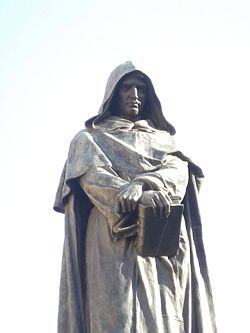Giordano Bruno
Giordano Bruno (1548 â February 17, 1600) was an Italian philosopher, priest, cosmologist, and occultist. He is known for his system of mnemonics based on organized knowledge, his ideas on extrasolar planets and extraterrestrial life, and his support of Nicolaus Copernicus's heliocentric model of the solar system. Like other early thinkers seeking a more reasonable view of the universe, Bruno adopted a model of the world comprising some aspects that have been incorporated into the modern scientific model and others, such as his animistic cosmology and disdain for mathematics, which are inconsistent with the modern scientific model.
Due to his highly unorthodox and strongly-held views, Bruno left the Dominican priesthood and Italy in search of a stable academic position in other European countries. Aside from seven productive years in France, however, he was unsuccessful in finding an academic institution willing to permit him to teach his ideas. Returning to Italy he continued to promote unorthodox views in the face of the then-strong Roman Inquisition, which jailed him for six years, convicted him of heresy, and burned him at the stake, hanging upside-down, gagged, and naked on February 17, 1600.
The Roman Inquisition killed Bruno essentially because his ideas were deemed to be too potentially disruptive of the social order and also because he was too successful in promulgating them. Such ruthless actions were noticeably ineffective in stemming the rising tide of a new worldview whose time had apparently come.
Early life
Born at Nola (in Campania, then part of the Kingdom of Naples) in 1548; he was originally named Filippo Bruno. His father was Giovanni Bruno, a soldier. At the age of 11 he traveled to Naples to study the Trivium. At 15, Bruno entered the Dominican Order, taking the name of Giordano. He continued his studies, completing his novitiate, and becoming an ordained priest in 1572.
He was interested in philosophy and was an expert on the art of memory; he wrote books on the mnemonic technique, which Frances Yates contends may have been disguised Hermetic tracts. The writings attributed to Hermes Trismegistus were, in Bruno's time, recently rediscovered and at that time were thought to date uniformly to the earliest days of ancient Egypt. They are now believed to date mostly from about 300 C.E. and to be associated with Neoplatonism. Bruno embraced a sort of pantheistic hylozoism, rather than orthodox Christian trinitarian belief.
Bruno was also heavily influenced by the ideas of Copernicus and by the newly rediscovered ideas of Plato as well as the teachings ascribed to Hermes Trismegistus.[1] Other influences included Thomas Aquinas, Averroes, John Duns Scotus, Marsilio Ficino, and Nicholas of Cusa.
In 1576 he left Naples to avoid the attention of the Inquisition. He left Rome for the same reason and abandoned the Dominican order. He traveled to Geneva and briefly joined the Calvinists, before he was excommunicated, ostensibly for his adherence to Copernicanism, and left for France.
In 1579 he arrived in Toulouse, where he briefly had a teaching position. At this time, he began to gain fame for his prodigious memory. Bruno's feats of memory were apparently based, at least in part, on an elaborate system of mnemonics, but many of his contemporaries found it easier to attribute them to magical powers.
For seven years, he enjoyed the protection of powerful French patrons, including Henry III. During this period, he published 20 books, including several on memory training, Cena de le Ceneri (âThe Ash Wednesday Supper,â 1584), and De l'Infinito, Universo e Mondi (âOn the Infinite Universe and Worlds,â 1584). In Cena de le Ceneri he defended the theories of Copernicus, albeit rather poorly. In De l'Infinito, Universo e Mondi, he argued that the stars we see at night were just like our sun, that the universe was infinite, with a "Plurality of Worlds," and that all were inhabited by intelligent beings. These two works are jointly known as his "Italian dialogues." In 1582 Bruno penned a play summarizing some of his cosmological positions, titled Il Candelaio ("The Torchbearer").
Travel years
In 1583, he went to England with letters of recommendation from Henry III of France. There he sought a teaching position at Oxford, but appears to have given offense and was denied a position there (and elsewhere in England).
In 1585 he returned to Paris. However, his 120 theses against Aristotelian natural science and his pamphlet against the Catholic mathematician Fabrizio Mordente soon put him in ill favor. In 1586, following a violent quarrel about "a scientific instrument," he left France for Germany.
In Germany he failed to obtain a teaching position at Marburg, but was granted permission to teach at Wittenberg, where he lectured on Aristotle for two years. However, with a change of intellectual climate there, he was no longer welcome, and went in 1588 to Prague, where he obtained three hundred taler from Rudolf II, but no teaching position. He went on to serve briefly as a professor in Helmstedt, but had to flee again when the Lutherans excommunicated him, continuing the pattern of Bruno's gaining favor from lay authorities before falling foul of the ecclesiastics of whatever hue.
The year 1591 found him in Frankfurt. Apparently, during the Frankfurt Book Fair, he heard of a vacant chair in mathematics at the University of Padua and he also received an invitation to Venice from one Zuane Mocenigo, who wished to be instructed in the art of memory. Apparently believing that the Inquisition might have lost some of its impetus, he returned to Italy.
He went first to Padua, where he taught briefly, but the chair he sought went instead to Galileo Galilei, so he went to the University of Venice. For two months he functioned as a tutor to Mocenigo, who probably was an agent of the Venetian Inquisition. When Bruno attempted to leave Venice, Mocenigo denounced him to the Inquisition, which had prepared a total of 130 charges against him. Bruno was arrested May 22, 1592, and given a first trial hearing before being sent for trial in Rome in 1593.
Trial and death
In Rome he was imprisoned for six years before he was tried, lastly in the Tower of Nona. He tried in vain to obtain a personal audience with Pope Clement VIII, hoping to make peace with the Church through a partial recantation. His trial, when it finally occurred, was overseen by the inquisitor, Cardinal Robert Bellarmine, who demanded a full recantation, which Bruno refused. Consequently, he was declared a heretic, handed over to secular authorities on January 8, 1600. At his trial, he said: "Perhaps you, my judges, pronounce this sentence against me with greater fear than I receive it." A month or so later he was brought to the Campo de' Fiori, a central Roman market square, his tongue in a gag, hung upside-down, naked, and burned at the stake, on February 17, 1600.
Since 1889, there has been a monument to Bruno on the site of his execution, erected by Italian Masonic circles.
All his works were placed on the Index Librorum Prohibitorum in 1603. Four hundred years after his execution, official expression of "profound sorrow" and acknowledgement of error at Bruno's condemnation to death was made, during the papacy of John Paul II. Attempts were made by a group of professors in the Catholic Theological Faculty at Naples, led by the Nolan Domenico Sorrentino, to obtain a full rehabilitation from the Catholic authorities.
The cosmology of Bruno's time
In the second half of the sixteenth century, the theories of Copernicus began diffusing through Europe. Although Bruno did not wholly embrace Copernicus's preference for mathematics over speculation, he advocated the Copernican view that the earth was not the center of the universe, and extrapolated some consequences that were radical departures from the cosmology of the time.
According to Bruno, Copernicus's theories contradicted the view of a celestial sphere, immutable, incorruptible, and superior to the sublunary sphere or terrestrial region. Bruno went beyond the heliocentric model to envision a universe which, like that of Plotinus in the third century C.E., or like Blaise Pascal's nearly a century after Bruno, had its center everywhere and its circumference nowhere.
Few astronomers of Bruno's generation accepted even Copernicus's heliocentric model. Among those who did were the Germans Michael Maestlin (1550-1631), Cristoph Rothmann, and the Englishman Thomas Digges, author of A Perfit Description of the Caelestial Orbes. Galileo (1564-1642) and Johannes Kepler (1571-1630) at the time were still young. Bruno himself was not an astronomer, but was one of the first to embrace Copernicanism as a worldview, rejecting geocentrism. In works published between 1584 and 1591, Bruno enthusiastically supported Copernicanism.
According to Aristotle and Plato, the universe was a finite sphere. Its ultimate limit was the primum mobile, whose diurnal rotation was conferred upon it by a transcendental God, not part of the universe, a motionless prime mover and first cause. The fixed stars were part of this celestial sphere, all at the same fixed distance from the immobile earth at the center of the sphere. Ptolemy had numbered these at 1,022, grouped into 48 constellations. The planets were each fixed to a transparent sphere.
Copernicus conserved the idea of planets fixed to solid spheres, but considered the apparent motion of the stars to be an actual motion of the earth; he also preserved the notion of an immobile center, but it was the Sun rather than the Earth. He expressed no opinion as to whether the stars were at a uniform distance on a fixed sphere or scattered through an infinite universe.
Bruno's cosmology
Bruno believed, as is now universally accepted, that the Earth revolves and that the apparent diurnal rotation of the heavens is an illusion caused by the rotation of the Earth around its axis. He also saw no reason to believe that the stellar region was finite, or that all stars were equidistant from a single center of the universe. Furthermore, Bruno also believed that the Sun was at the center of the universe. In these respects, his views were similar to those of Thomas Digges in his A Perfit Description of the Caelestial Orbes (1576).
However, Digges considered the infinite region beyond the stars to be the home of God, the angels, and of the holy. He conserved the Ptolemaic notion of the planetary spheres, considered Earth the only possible realm of life and death, and a unique place of imperfection and change, compared against the perfect and changeless heavens.
In 1584 Bruno published two important philosophical dialogues, in which he argued against the planetary spheres. Bruno's infinite universe was filled with a substanceâa "pure air," aether, or spiritusâthat offered no resistance to the heavenly bodies which, in Bruno's view, rather than being fixed, moved under their own impetus. Most dramatically, he completely abandoned the idea of a hierarchical universe. The Earth was just one more heavenly body, as was the Sun. God had no particular relation to one part of the infinite universe more than any other. God, according to Bruno, was as present on Earth as in the Heavens, an immanent God rather than a remote heavenly deity.
Bruno also affirmed that the universe was homogeneous, made up everywhere of the four elements (water, earth, fire, and air), rather than having the stars be composed of a separate quintessence. Essentially, the same physical laws would operate everywhere. Space and time were both conceived as infinite.
Under this model, the Sun was simply one more star, and the stars all suns, each with its own planets. Bruno saw a solar system of a sun/star with planets as the fundamental unit of the universe. According to Bruno, an infinite God necessarily created an infinite universe that is formed of an infinite number of solar systems separated by vast regions full of aether, because empty space could not exist (Bruno did not arrive at the concept of a galaxy). Comets were part of a synodus ex mundis of stars, and notâas other authors asserted at the timeâephemeral creations, divine instruments, or heavenly messengers. Each comet was a world, a permanent celestial body, formed of the four elements.
Bruno's cosmology is marked by infinitude, homogeneity, and isotropy, with planetary systems distributed evenly throughout. Matter follows an active animistic principle: it is intelligent and discontinuous in structure, made up of discrete atoms. The cosmos and its components acted independently with characteristics of living creatures. This animism (and a corresponding disdain for mathematics as a means to understanding) is the most dramatic aspect in which Bruno's cosmology differs from what today passes for a common-sense picture of the universe.
Notes
- â Stephan A. Hoeller, âOn the Trail of the Winged God: Hermes and Hermeticism Throughout the Ages,â Gnosis: A Journal of Western Inner Traditions 40 (Summer 1996). Available online. Retrieved August 21, 2007.
ReferencesISBN links support NWE through referral fees
- Bruno, G. 1584. La Cena de le ceneri, ed. G. Aquilecchia, Turn: Giulio Einaudi, 1955; trans. S.L. Jaki, The Ash Wednesday Supper. La Cena de le Ceneri, The Hague and Paris: Mouton, 1975; trans. E. Gosselin and L. Lerner, The Ash Wednesday Supper: La cena de le ceneri. Reprint edition. Toronto: University of Toronto Press, 1995. ISBN 0802074693
- Gatti, Hilary. Giordano Bruno and Renaissance Science. Ithaca, NY: Cornell University Press, 2002. ISBN 0801487854
- Singer, D. W. Giordano Bruno: His Life and Thought with Annotated Translation of His Work 'On the Infinite Universe and Worldsâ. New York: Henry Schuman, 1950.
- Yates, Frances A. Giordano Bruno and the Hermetic Tradition. Chicago: University of Chicago Press. New edition, 1991. ISBN 0226950077
External Links
All links retrieved May 22, 2024.
- Writings of Giordano Bruno (1548-1600) â Twilit Grotto: Archives of Western Esoterica
General Philosophy Sources
- Stanford Encyclopedia of Philosophy
- Paideia Project Online
- The Internet Encyclopedia of Philosophy
- Project Gutenberg
Credits
New World Encyclopedia writers and editors rewrote and completed the Wikipedia article in accordance with New World Encyclopedia standards. This article abides by terms of the Creative Commons CC-by-sa 3.0 License (CC-by-sa), which may be used and disseminated with proper attribution. Credit is due under the terms of this license that can reference both the New World Encyclopedia contributors and the selfless volunteer contributors of the Wikimedia Foundation. To cite this article click here for a list of acceptable citing formats.The history of earlier contributions by wikipedians is accessible to researchers here:
The history of this article since it was imported to New World Encyclopedia:
Note: Some restrictions may apply to use of individual images which are separately licensed.



